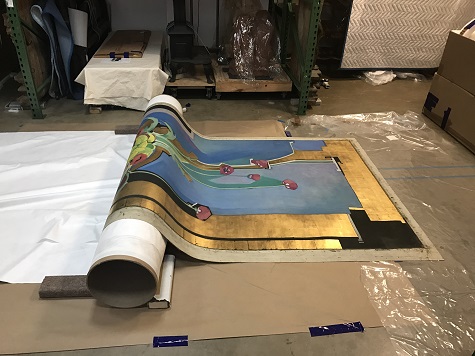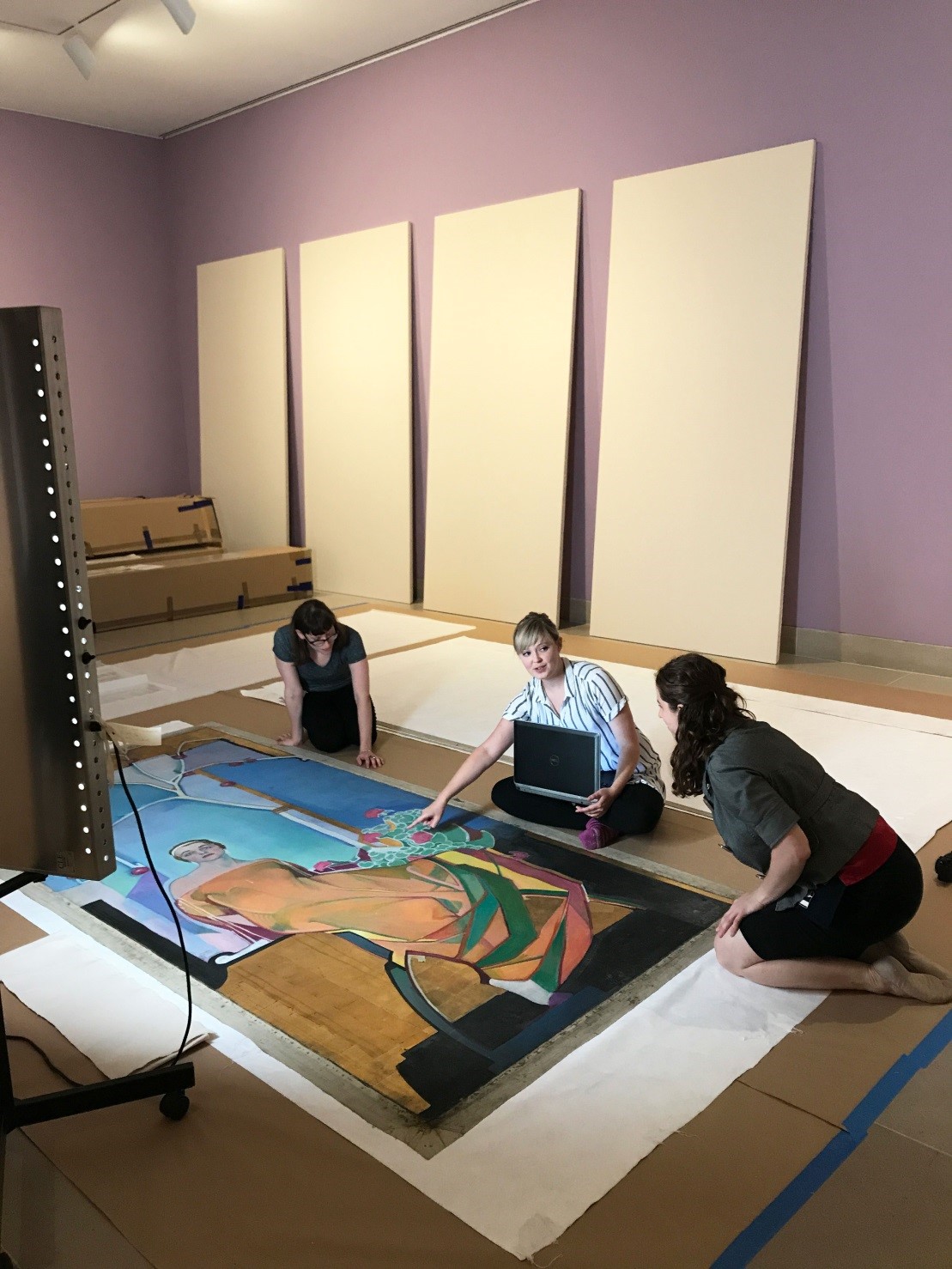Seven murals painted by Edward Steichen are undergoing conservation treatment this summer in the DMA’s Cindy and Howard Rachofsky Quadrant Gallery. After treatment is completed, the rare and exquisite murals will be on view September 5, 2017, through May 28, 2018, as part of the exhibition Edward Steichen: In Exaltation of Flowers (1910-1914), overseen by the Pauline Gill Sullivan Associate Curator of American Art at the DMA, Sue Canterbury.
Edward Steichen, born Eduard Jean Steichen in 1879, was an American artist who was both a painter and photographer during his lifetime. Most of his paintings and photographs were produced for the American art market while he was living in the United States or France. He stayed in Paris for about a year in 1901 and then returned to Paris a second time in 1906; it was then that he joined the New Society of American Artists. One of his friends in Paris was an American student at the Sorbonne named Agnes Ernst, and she later played a large role in Steichen’s commission for In Exaltation of Flowers. In 1908, Steichen moved from Paris to his villa, L’Oiseu Bleu, in Voulangis, France. There, he cultivated a garden and built a small studio with a skylight.
In 1910 Agnes Ernst married Eugene Meyer and the couple traveled to L’Oiseu Bleu during their honeymoon. The three friends likely discussed the commission for In Exaltation of Flowers during that visit. This commission would include seven 10-foot-tall murals designed for a foyer in the Meyers’ new townhouse at 71st Street and Park Avenue, which the Meyers acquired in 1911. The commission was $15,000 and these artworks became Steichen’s most ambitious undertaking.
As Steichen worked on the Meyers’ commission from 1910 to 1914, many of their American friends visited Voulangis, including Arthur Carles, Mercedes de Cordoba, Katharine Rhoades , Marion Beckett, and Isadora Duncan. Some of these visitors identified with specific floral personifications, which became incorporated into Steichen’s tempera and gold leaf compositions. The In Exaltation of Flowers series consists of the following seven panels:
-
- Gloxinia – Delphinium: a kneeling woman (likely Isadora Duncan) with Gloxinia, Delphinium, and Caladium flowers
- Clivia – Fuchsia – Hilium – Henryi: one woman sitting (possibly Isadora Duncan or Marion Beckett) and another woman standing (likely Katharine Rhoades) with Clivia, Fuchsia, and Henry Lily flowers
- Coleus – The Florence Meyer Poppy: Florence Meyer (first child of Eugene and Agnes Meyer) with a butterfly and poppies
- Petunia – Begonia – The Freer Bronze: a Zhou Dynasty bronze (symbolizing Charles Lang Freer, a collector of Asian art and benefactor of the Freer Gallery in Washington, DC) with Petunia and Begonia flowers
- Rose – Geranium: Katharine Rhoades with a fruit-bearing tree, roses, and geraniums
- Petunia – Caladium – Budleya: two standing women (Marion Beckett and an unidentified woman in the background), with Petunia, Iris, Caladium, and Budleya (other spelling variants include Buddleia and Buddleja) flowers
- Golden Banded Lily – Violets: a standing woman (likely Agnes Meyer) with Golden Banded Lily and Violet (also identified as Begonia rex) flowers
Even before receiving the Meyers’ commission, Steichen had been painting and photographing women and flowers; however, his depiction of the subject matter and use of gold leaf in In Exaltation of Flowers alludes to influences from French couture designer Paul Poiret and Art Nouveau painters Gustav Klimt, Alphonse Mucha, Pierre Bonnard, and Maurice Denis.
All seven murals in In Exaltation of Flowers were completed by 1914. Even though they had originally been commissioned for the townhouse on 71st Street and Park Avenue, the paintings were never displayed in that building. Due to financial hardship, the Meyers had to sell their townhouse earlier in 1914, and Steichen’s intended sequence for the murals remains unknown today. The order listed above is based on a 1915 checklist from their presentation at the Knoedler Galleries in New York. Two of the murals were later displayed at the Pennsylvania Academy in 1921 and 1996, and at least one mural was displayed at the Board of Governors of the Federal Reserve System in 1988. The DMA’s presentation this fall of the murals, which are part of a private collection, will mark the first time the seven panels have been exhibited together since their debut at the Knoedler Galleries 102 years ago.
References
Murphy, Jessica. Portraiture and Feminine Identity in the Stieglitz Circle: Agnes Ernst Meyer, Katharine Rhoades, and Marion Beckett. Dissertation. University of Delaware, 2009.
Goley, Mary Anne and Barbara Ann Boese Wolanin. From Tonalism to Modernism: The Paintings of Eduard J. Steichen, October 4–December 9, 1988. Washington, DC: Board of Governors of the Federal Reserve System, 1988.
Haskell, Barbara. Edward Steichen. New York: Whitney Museum of American Art, 2000.
Pusey, Merlo J. Eugene Meyer. New York: Alfred A. Knopf, 1974.
Keara Teeter is a Conservation Intern at the DMA.


